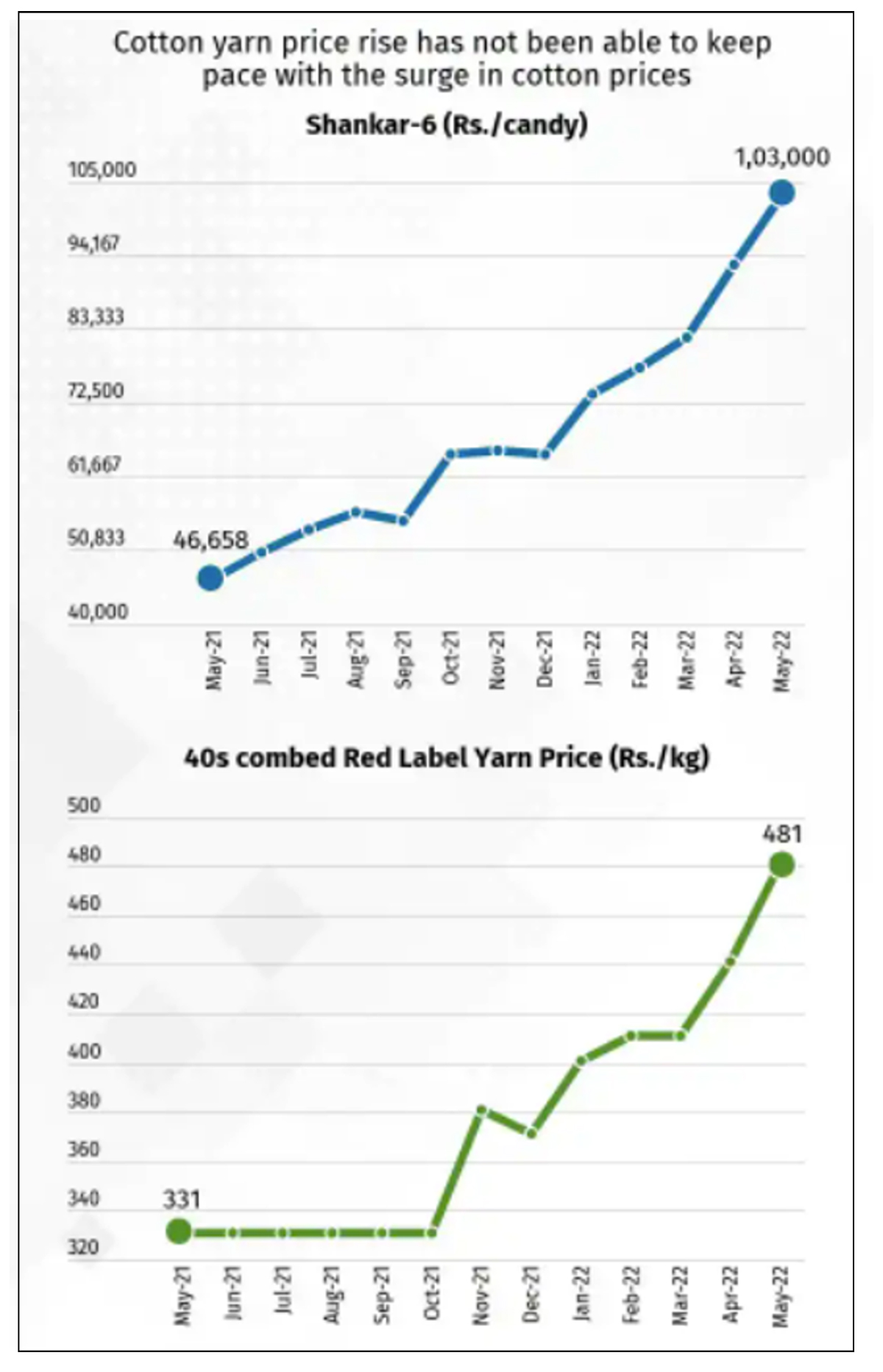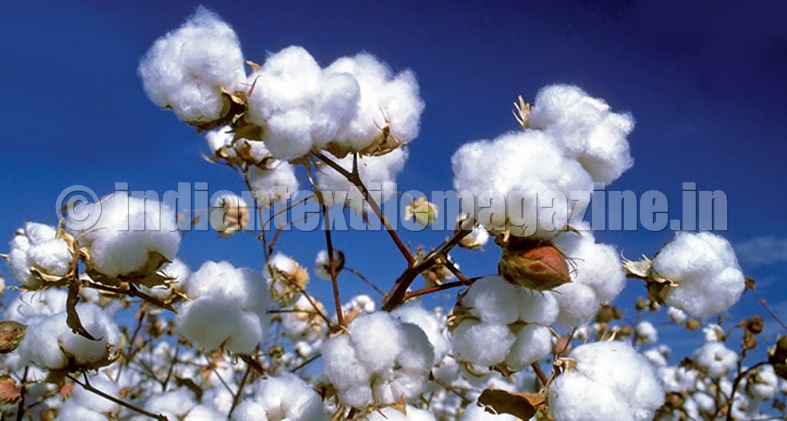Cotton price rise playing a spoilsport for the textile value chain
By Gurudas Aras
Strategic Advisor, ITA Group (Germany), Rabatex Industries, Yamuna Machine, Piotex Ventures
Independent Director, Rossari Biotech Group of Companies

The Indian textile industry had been one of the industries to bounce back the fastest, in the post pandemic days. The China+1 policy of global buyers, Government’s support with many innovative schemes and availability of raw material at reasonable prices had put India back on the global textile map as one of the attractive destinations, only nearly a year back. Spinning mills had been enjoying one of the best profit margins over the last few quarters. On the back of low cost of cotton, increased yarn demand and increase in yarn & fabric prices, it brought one of the best days for the industry. After a robust $16 billion worth cotton apparel exports in FY 2022, the current year forecast had been set at optimistic $19 billion.
However, such fortunes proved to be short-lived with cotton prices playing a spoilsport. The unabated cotton price surge over the last few months have raised a basic question about the very survival of the textile industry in India. Cotton prices which were around Rs. 46,000 a candy (356 kgs) last May have now reached Rs. 103,000 (Sankar-6). Nearly 75% of the rise has been in this calendar year itself. The rise in raw material cost alongside increase in labour, energy and transportation cost has put the entire textile value chain in jeopardy. At present the spinners are incurring cash losses of Rs. 25 to Rs. 50 per kg of yarn. Relentlessly increasing raw material prices has been a big hurdle now for the entire textile value chain including the manufacturers and exporters as well.

The stress of the spinning industry has now been further transmitted to fabrics and garments since the increased yarn prices are no more affordable and economical. Thus the whole textile value chain is under shake up due to cotton price increase to unprecedented level.
Will the cotton prices soften now after a long period of increase?
The industry is hoping for softening of the cotton prices after a long spell of increase which has made manufacturing of yarn a loss-making proposition and also manufacturing of fabrics and garments uneconomical. Many spinning mills have either curtailed the production up to 40 to 50% while some have resorted to closure of the plants for few days.
The mute question is “Are the cotton prices likely to come down in the near future bringing back the smiles on the faces of the industry?”. In my sincere opinion the answer is clear “NO”, although it may sound pessimistic. A month back the World Bank also predicted the international cotton prices to surge 40% this year. The upward movement isn’t expected to stop anytime soon, for sure. The reasons for this forecast are given below.
- A shortfall in the Indian cotton crop for year 2022 as per the Cotton Association of India (323 lakh bales against the estimate of 353 lakh bales)
- Failure of US crop due to drought conditions in Texas (the highest cotton growing province), resulting in a US cotton supply shortfall
- Expected shortage of global supply of cotton vis a vis a very robust demand from the user industry post-pandemic
- Globally some cotton areas have been lost to soybeans, corn and other products where prices have already skyrocketed giving farmers a greater bang for their bank
- Although spinning mills in India have reduced the yarn production, the incoming cotton supply is also reduced considerably due to hoarding by traders and speculators
- Ongoing Russia-Ukraine crisis have made energy and commodity prices sky rocket since the beginning of the war and this will keep even the cotton prices at a higher level
- At least 3 months gestation time for the arrival of imported cotton and higher freight costs will restrict the cotton imports
- Export of 42 lakh bales already done without proper assessment about likely shortfall in cotton production
Is there a long-term solution to the cotton price volatility issue?
In my opinion, in the short term, there is no solution to this issue as the supply-demand imbalance is playing out on the pricing dynamics. However, India being one of the top most cotton producing and cotton textile exporting countries, it needs to take a very serious view of this problem and seek a long-term solution. In my view the following suggestions, with a long-term view, might help in resolving this issue.
Efforts on increasing the cotton yield:
Although India is the highest cotton producing country in the world, the Indian cotton yield is one of the lowest in the world at only 469 kgs/hectare against the world average of 808 kgs/hectare. There is a large scope to improve the yield to bring it up to at least the world average. A serious effort is needed from the agriculture ministry & the textile industry for increasing the yield by use of best technology, promoting high-yielding seed varieties and training the farmers in best farming practices. Corporate farming of cotton can be a way forward for the industry. In India nearly 80% cotton crop is still rain fed and hence vulnerable to the vagaries of the monsoon. Serious efforts are needed to increase irrigated areas in the country to reduce this problem. Also, many a times the crops are damaged due to pest attacks as well as some crop diseases. An early warning mechanism and preventive measures will help save the precious crops.
Blending with other similar fibres:
There are many cellulose based & man-made fibres now available which are very close to cotton in properties. As already started by many spinning mills by now, blending with fibres like Viscose, Lyocell and Modal having similar properties to cotton is necessary for reducing the dependence on cotton. Some of these fibres even have better properties than cotton in some respects like durability, softness, etc. Even the blends with some natural fibres like Bamboo, Flex and Hemp are becoming popular due to improved properties, including better look & feel, given to the fabrics.
Increase use of recycled/regenerated cotton:
In order to reduce dependability on new crop cotton and also contributing to the bigger cause of “Circular Economy” it would be best to recycle the cotton waste in order to recover fibres as well as use the process to regenerate the fibres from used cotton garments. This will also help reducing the textile & clothing waste which generally finds its place to landfills thus polluting the environment. Also, it will help immensely to the cause of Sustainability.
Control and monitoring of the raw cotton exports:
With the export of raw cotton (78 lakh bales in 2021), India loses great opportunity of value addition and also creates a raw material shortage in case of a lower crop. The government needs to be conscious of the sensitivity of this issue and keep monitoring the cotton availability situation while allowing raw cotton exports. However, it would be best if not even a single bale of cotton is exported but instead the value-added products like the finished textiles, made ups and garments are exported. However, this needs a strong will and a clear bule print from both the industry and the government.
Increase the consumption of man-made fibres:
India has so far missed a bigger opportunity in the global markets due to its cotton heavy product portfolio. Majority of the global textile trade happens in man-made fibre based products. By increasing the usage of man-made fibres in textile manufacturing we will broaden our product basket for exports, and this will have lots of benefits. One would be that of increasing our share in the global trade through increased exports and other would be of reducing the over-dependence on cotton.

What will happen after the new crop season starts?
The metrological department has given a forecast of close to normal rains in major part of India. This is really good news for cotton crop since majority of the cotton crop comes from rain fed area. Also, in view of the higher prices of cotton over nearly a year, the farmers have enjoyed one of the highest profits in a decade. As a result, I expect a much higher acreage of land to come under cotton cultivation in the coming season. These two factors have raised hopes for higher cotton production in the coming new season and hence hopes for softening of cotton prices after the new season starts.
In conclusion, although Indian textile industry is staring at one of the worst raw material crises of decades there are many lessons to be learnt and beyond that the industry and the government needs to take decisive corrective actions to avoid such situation in future. The growth trajectory in which our industry was going post-pandemic has temporarily been tapered down by the present challenges. However, in the long-term Indian textile industry will certainly bounce back with increased vigour.